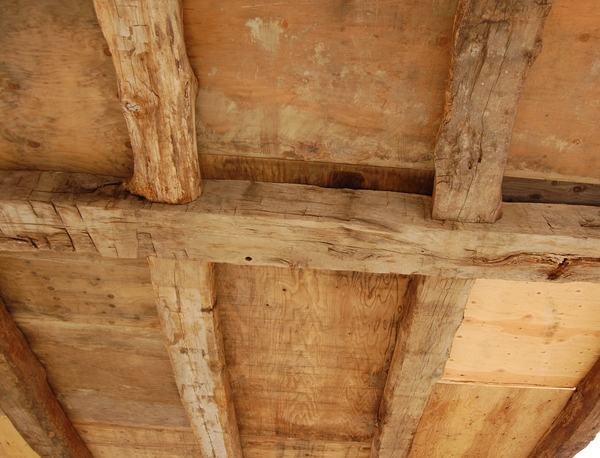
George and Joan Hornig are passionate people. Whether it’s about restoring an old 1860s-era barn on their property to its original splendor or donating time, money and resources to those in need, the Water Mill couple—he’s the Chief Operating Officer for Pine Bridge Investments and she’s a successful high-end jewelry designer and founder of the philanthropic Joan B. Hornig Foundation—are serious advocates for what they believe in, chiefly environmental conservation and the arts.
The pair, who have been married for decades yet seem to be as in love as newlyweds, have spent a lifetime together sharing their interests with each other and their considerable resources with many. Primary among their interests are family time with daughters Julia and Jessica, outdoor activities, entertaining and supporting the arts, particularly here on the East End. And their latest project—restoring a 150-year-old barn at their second home here—contains elements of their most favorite things. One might say that the couple’s latest project joins together their goals as perfectly as the mortise and tenon joints used to reconstruct the old barn.
While touring the construction last month, Mr. Hornig talked about his passion for researching the old barn materials and building methods that were used in the days before power tools and even nails.
“I think I have every barn book in print,” he laughed.
Mr. Hornig explained that conservation is important to his family and that he and his wife wanted to restore their part of the Hamptons to its original beauty. Their property, once owned by the Burnett family for generations, was “classic Hamptons farmland” used to grow potatoes and corn and to breed livestock, he said.
“Just preserving an aspect of what was here rather than just mowing it all down; that’s good,” he said. “It’s been a personal project for Joan and me.”
Contractor Mark Rist from East Quogue-based Rist Builders Inc. explained the construction logistics of putting the “old Burnett barn,” which was used by the property’s previous owners, back together. The original structure, which was no longer structurally sound, was torn down last August and is being reconstructed—using reclaimed timber and quite a bit of the original hardware to follow the same footprint as the original 3,000-square-foot structure, with an additional 800-square-foot loft upstairs.
The project, drawn up by Southampton architect John Rose, is expected to be fully completed by the year’s end, after approximately 50 weeks of six men working 40 hours each a week, Mr. Rist estimated. The exterior will be done by summertime, he added. Parts of the building will be put to use as an arts salon and fundraising space this summer, according to Ms. Hornig, who is known for putting on A-level benefits and events (noted, she has thrown parties for the Obamas and the Clintons).
The style of the barn, referred to as an English barn with “Yankee style,” meaning that there are cross-angle beams, is being constructed entirely with mortise and tenon joints with nary a nail in place.
“It’s the only one of its kind out here, far as I know,” Mr. Rist said. “We’re putting it back to the way it was.”
Most of the reclaimed wood—hand-hewn oak and fir, old barn siding and tongue-and-groove chestnut for the flooring and 22-foot-long beams for the rafters—came from western Pennsylvania, Maryland and New Jersey, Mr. Rist said. He estimated that the project would take somewhere in the neighborhood of 60,000 pounds of wood.
Even the manner of constructing the building had to be looked at differently, Mr. Rist said, as he showed off a wooden mallet he fashioned to drive in wooden “nails.”
“We made our own soft hammer,” he said. “If you hit this with metal, it would destroy the wood.”
Even though Mr. Hornig devoted hours and hours to research barn construction, it was actually his wife who came up with the idea for restoration, and for the eventual purpose of the barn, he said.
“This is Joan’s project. It’s conceived from her vision,” he said as he beamed at his wife.
“I loved this property the second I saw it,” she added.
Using the barn and the rest of the Water Mill property the couple calls “Camp Hornig,” for the greater good is what Ms. Hornig plans. She said that her philosophy is to give back as much as possible.
“If you have it, you’re supposed to share it,” she said simply. Ms. Hornig donates 100 percent of her jewelry profits through her foundation.
“This is a great space to make money to donate,” she said. “When it finally gets done, it will be used to make a difference. The barn is a metaphor for working the mind and changing the world.”
Mr. Hornig agreed with his wife, adding that paying homage to the beauty of the East End was also a factor in his decision for restoration.
“It’s about the history of this place and land, to be connected to what was here and the generations that worked the land. Looking around, you lose some of the roots and connection that tie back to what was the Hamptons before they were the Hamptons we know today,” he said.
And paying tribute to another natural resource, the talent that lives on the East End, the barn and an accessory English-style conservatory structure, which will be primarily a glass and copper construction, will also be used as a salon/gallery/exhibit space, Ms. Hornig said.
“I envision it to be a place for young artists to show their work, to build audiences for what we think the Hamptons are all about. We are more than a resort community,” she said emphatically. “It will be a place for lectures to build an intellectual and creative foundation, a stage for learning, for giving back and for participating. We all have a call to action.”